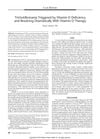Trichotillomania Across Circuits: Neurobiology, Sensory Processing, and Genetic Insights
August 2025

TLDR Trichotillomania involves hair-pulling due to brain and genetic factors, with behavior therapy and new drugs showing promise, but challenges like stigma and underdiagnosis persist.
Trichotillomania, a hair-pulling disorder affecting 1-2% of the population, is now recognized as a distinct neurobehavioral condition with unique clinical and neurobiological features. This review highlights the disorder's association with dysregulated reward circuits, abnormal sensory processing, and potential genetic factors. While behavior therapy remains the first-line treatment, new pharmacological approaches targeting glutamatergic and dopaminergic pathways show promise, especially where traditional treatments have failed. Additionally, technology-enabled interventions are expanding treatment options. Despite these advances, challenges such as stigma-driven underdiagnosis, limited provider training, and a lack of large-scale trials persist. The review emphasizes the need for an integrative approach to improve outcomes and address these gaps in care.



